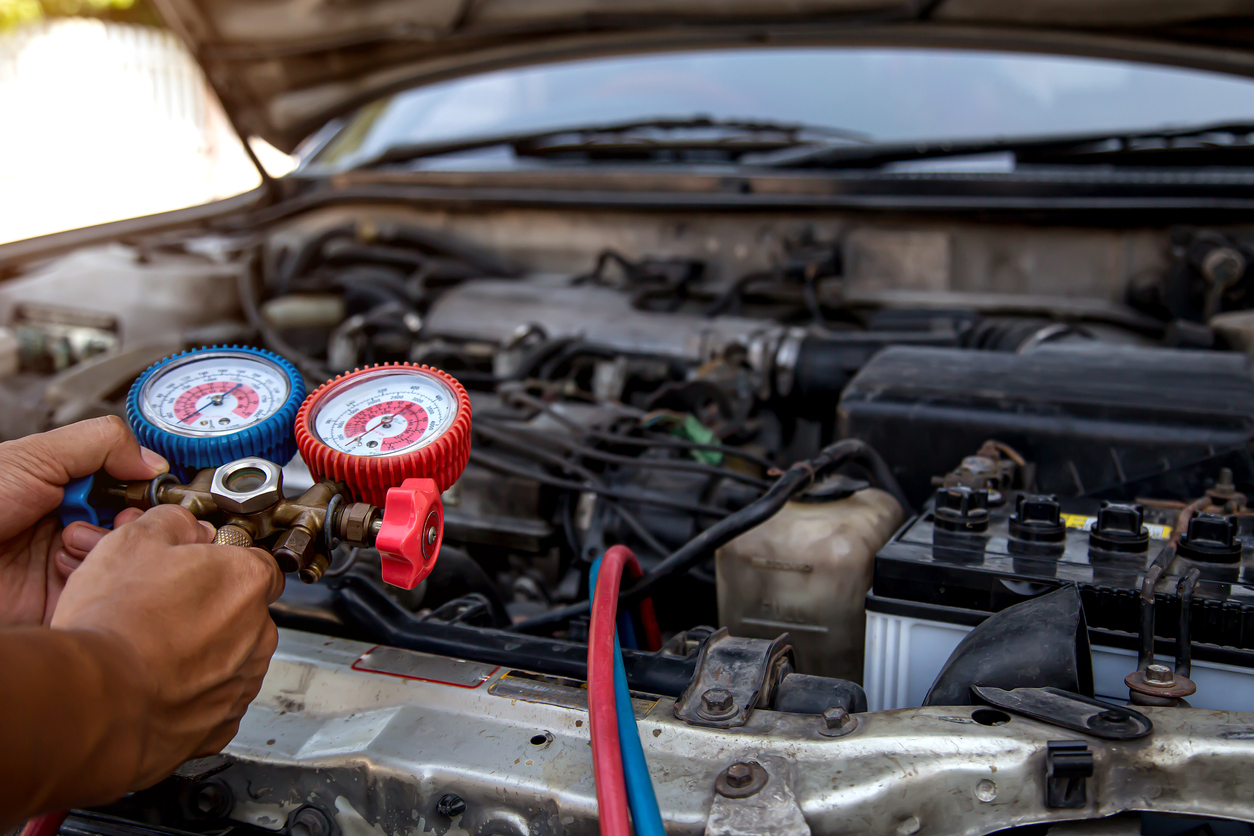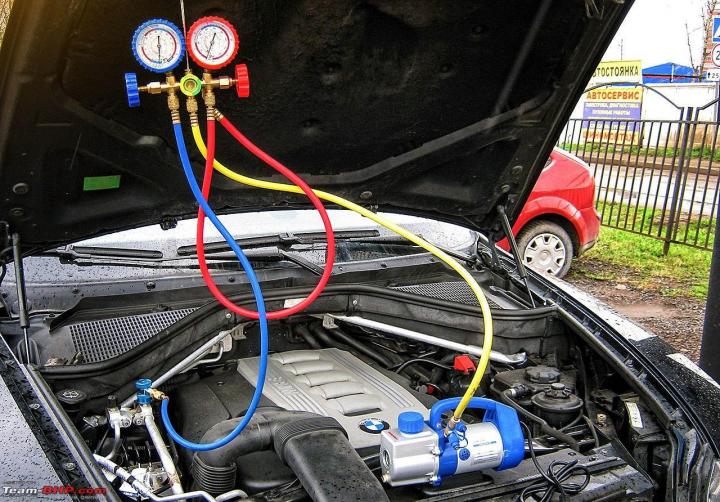How to Vacuum And Recharge Car Ac
To vacuum and recharge your car AC, use a vacuum pump to remove old refrigerant. Then, add new refrigerant to the system.
When it comes to maintaining your car’s AC system, regularly vacuuming and recharging the system is crucial for optimal performance. This process helps remove any buildup of impurities and ensures efficient cooling. By following a few simple steps, you can ensure that your car’s AC system functions at its best, keeping you comfortable during your drives.
Next, let’s explore the specific steps involved in vacuuming and recharging a car AC system to help you maintain your vehicle’s cooling capabilities.

Credit: www.autozone.com
Preparing Your Car
Checking The Ac System
Before starting the vacuum and recharge process, it’s crucial to ensure that the AC system in your car is in good condition. Checking the AC system involves examining the refrigerant level, identifying any visible leaks, and inspecting the AC compressor for any signs of damage or wear. If you notice any issues during the inspection, it’s best to address them before proceeding with the vacuum and recharge procedure.
Gathering The Necessary Tools
Having the right tools at hand is essential for successfully vacuuming and recharging your car’s AC system. Gather the necessary tools such as a vacuum pump, manifold gauge set, refrigerant, and safety equipment including gloves and safety goggles. Additionally, ensure that you have the appropriate refrigerant for your car’s AC system, as using the wrong type can lead to performance issues. By preparing the required tools beforehand, you can streamline the vacuuming and recharging process and minimize interruptions.

Credit: m.youtube.com
Removing Refrigerant
Locating The Low-pressure Port
First, identify the low-pressure port on your car’s AC system.
Connecting The Vacuum Pump
Once located, connect the vacuum pump to the low-pressure port securely.
Vacuuming The Ac System
Learn how to effectively vacuum and recharge your car’s AC system with this easy step-by-step guide. Keep your vehicle cool and comfortable during hot summer months with these simple instructions.
Operating The Vacuum Pump:
Use the vacuum pump to remove air and moisture from the AC system. Turn on the pump and let it run for a minimum of 30 minutes.Waiting For The System To Reach 30 Inhg:
Monitor the gauge until it reads at least 30 inHg. Be patient as this step ensures a properly evacuated AC system. Start the vacuuming process by attaching the low-side hose of the gauge set to the low-side port of the AC system. Turn the AC system on and set it to the maximum cooling setting. Connect the high-side hose of the gauge set to the high-side port of the system. Open both the high and low knobs on the gauge set, enabling the vacuum pump to start removing air from the AC system. Watch the vacuum gauge to ensure it reaches at least 30 inHg.Ensuring Each Heading Adheres To Html Syntax:
Make sure the content is wrapped in proper HTML tags. Be precise in your HTML coding to maintain structure and readability. Remember to include the necessary opening and closing tags within each H3 heading. Follow HTML syntax standards for optimal SEO performance. In a table, summarize the steps involved in vacuuming the AC system with the vacuum pump: | Step | Description | | — | — | | 1 | Attach low-side hose to low-side port | | 2 | Turn on pump for at least 30 minutes | | 3 | Connect high-side hose to high-side port | | 4 | Open both high and low knobs on gauge set | | 5 | Monitor gauge until 30 inHg is reached | Keep the focus on precision and efficiency in vacuuming the AC system to ensure a successful recharge process.Adding Refrigerant Oil
Adding Refrigerant Oil is an essential step in the process of vacuuming and recharging your car AC system. Refrigerant oil helps lubricate the moving parts of the AC compressor and ensures smooth functioning of the system. Properly injecting the right amount of refrigerant oil is crucial for maintaining the efficiency and longevity of your car’s AC system.
Locating The High-pressure Port
Before injecting refrigerant oil, it is important to locate the high-pressure port on your car AC system. The high-pressure port is typically located near the AC compressor and is identifiable by its larger size compared to the low-pressure port. Additionally, the high-pressure port is often labeled with an “H” or marked in a different color for easy identification.
Injecting The Refrigerant Oil
Once you have located the high-pressure port, you can proceed with injecting the refrigerant oil into the car AC system. This process should be done carefully to avoid overfilling or underfilling the system, which can lead to inefficiencies or damages. Using a refrigerant oil injector tool, connect the injector to the high-pressure port and slowly inject the specified amount of refrigerant oil into the system as recommended by your car’s manufacturer.
Recharging The Ac System
Recharging your car’s AC system is an essential maintenance task that ensures you stay cool and comfortable during those hot summer months. Over time, refrigerant can leak from the system, causing your air conditioner to blow warm or insufficiently cooled air. By recharging the AC system, you can restore its cooling effectiveness and enjoy a comfortable driving experience.
Connecting The Recharge Kit
Before you start recharging your car’s AC system, it’s crucial to have the right tools and equipment. You’ll need an AC recharge kit, which typically includes a canister of refrigerant, a pressure gauge, and a hose with a connector. These kits are widely available at auto supply stores and are designed for easy use by car owners.
To begin the recharging process, locate the low-pressure service port in your vehicle’s AC system. This port is usually located near the compressor and is identifiable by its distinctive black or blue cap. Once you’ve located the port, remove the cap, and attach the hose connector from the recharge kit.
Adding Refrigerant
With the recharge kit properly connected, it’s time to add refrigerant to your AC system. Start the car’s engine and turn on the air conditioner to its maximum cooling setting. Next, follow the instructions on the recharge kit to activate the flow of refrigerant into the system. This typically involves turning a knob or pressing a lever on the gauge.
| Note: |
|
As you add refrigerant, you may hear the compressor cycling on and off, indicating that the system is receiving the necessary cooling agent. Continue adding refrigerant until you reach the recommended pressure range on the gauge or until the gauge indicates that the system is properly charged.
Once the recharge is complete, carefully disconnect the hose connector from the low-pressure service port, and replace the cap. It’s important to handle the refrigerant and canister with care as they contain potentially harmful substances.
By following these steps and recharging your car’s AC system regularly, you can ensure optimal cooling performance and a comfortable driving experience even on the hottest of days.

Credit: www.team-bhp.com
Frequently Asked Questions On How To Vacuum And Recharge Car Ac
Do You Need To Vacuum Ac Before Recharge?
Yes, it’s necessary to vacuum the AC before a recharge to remove any air and moisture. This ensures proper functioning and prevents damage.
How Much Does It Cost To Vacuum And Recharge Car Ac?
Vacuuming and recharging car AC typically costs between $100 to $150. Prices may vary based on location and vehicle type.
How Can I Vacuum My Car Ac Without A Pump?
To vacuum your car AC without a pump, use a vacuum cleaner with a hose attachment. Connect the hose to the vent and set the vacuum to high. Move the hose around to remove dirt and debris from the system.
How Long Does It Take To Vacuum And Recharge Car Ac?
Vacuuming and recharging a car AC system typically takes around 1-2 hours. It ensures proper functioning and optimal cooling. Regular maintenance extends the life of the system.
Why Is It Important To Vacuum And Recharge Car Ac?
Proper maintenance of your car’s AC system ensures its efficiency, prevents potential breakdowns, and extends its lifespan.
How Often Should I Vacuum And Recharge My Car Ac?
It is recommended to vacuum and recharge your car’s AC every 1-2 years to maintain optimal cooling performance.
Can I Vacuum And Recharge My Car Ac Myself?
While it is possible to DIY, it is best to have a professional handle the task to ensure proper vacuuming, refrigerant charging, and leak detection.
Conclusion
Maintaining your car’s AC system is essential for comfortable drives. Regular vacuuming and recharging will ensure optimal performance and extend the lifespan of the system. Following these simple steps can help you save time and money in the long run, keeping you cool and safe on the road.
